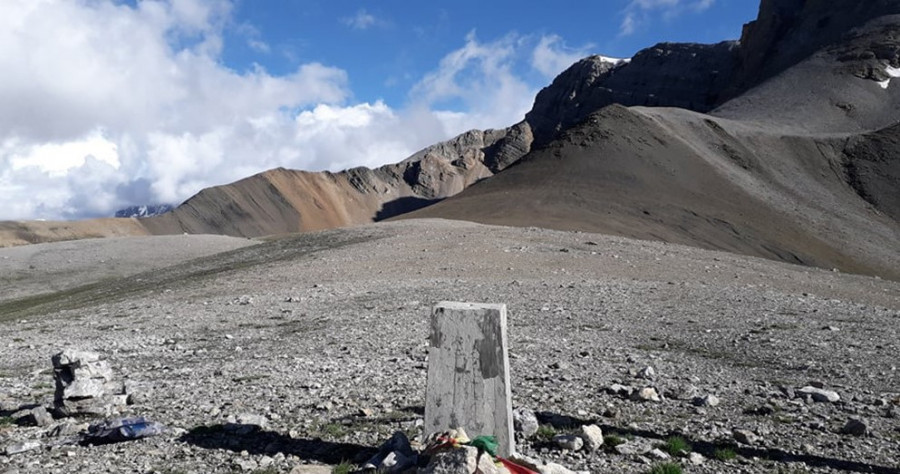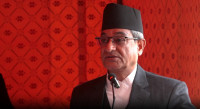National
Nepal, China agree to activate existing boundary mechanisms
Mechanisms will be formed soon, either during Foreign Minister Narayan Khadka’s upcoming China visit, or at another bilateral meeting, officials say.
Anil Giri
Nepal and China on Thursday agreed to activate the existing boundary mechanisms through mutual consultation.
During the joint consultation meeting on border affairs held virtually between the officials from Nepal and China, both sides agreed to activate the existing boundary mechanisms and a formal decision will be announced soon, according to Foreign Ministry officials.
Underscoring the importance of a joint inspection of the Nepal-China boundary, the two sides agreed to initiate the process for activating the existing bilateral mechanisms through mutual consultations, the Ministry of Foreign Affairs said in a statement.
Lok Bahadur Thapa, head of the North East Asia Division of the Ministry of Foreign Affairs, and Hong Liang, director general of the Department of Border and Ocean Affairs of the Ministry of Foreign Affairs of China, led their respective delegations to the meeting.
According to officials and experts, Nepal and China have a dispute over pillar number 57 in Dolakha district which was a major bone of contention after the height of Mt Everest, which was settled in December, 2020. Besides pillar no 57, disputes have often surfaced in Humla, Gorkha, Kimathanka (Sankhuwasabha), which should be resolved through joint inspection, Buddhi Narayan Shrestha, a noted cartographer and former director general of the Department of Survey, told the Post on Wednesday. Besides resolving the dispute, as per the boundary protocol, both sides should regularly update the status of the boundary every 10 years, he said.
The 1963 Joint Boundary Protocol has the provision of constituting three different mechanisms to deal with boundary issues—Joint Inspection Team, Joint Expert Group, and Joint Inspection Committee.
The mechanisms were enshrined in the Nepal-China Boundary Protocol signed between the two countries on January 20, 1963.
The Nepali side, during the official visit of Chinese Foreign Minister Wang Yi, who is also the State Councillor of China, in March, had proposed forming a mechanism in order to conduct joint inspection of the border and update the latest status.
The Nepal-China border spans 1,439 kilometres.
The officials of the two countries have yet to decide whether to resume the work from where it was left in 2011 or start afresh.
“Once we settle this issue, the next meeting will take the decision of forming the bilateral mechanisms,” the official said. “Mechanisms could be formed during the upcoming visit of Foreign Minister Narayan Khadka to China in near future or any other diplomatic consultation.”
The two countries signed the last (third) boundary protocol in 1988.
They then constituted the three mechanisms in 2006 which worked until 2011, according to officials.
After 2011, both sides had hardly discussed and took initiative to hold the boundary consultation meeting in order to conduct joint inspection of the border.
“The only issue remaining between us is where to begin the inspection from, after activating the mechanism,” a senior official said. “Should we start afresh or give continuity to the position where we left the issue in 2011?”
After signing the protocol in 1963 which followed the signing of the Nepal-China Border Treaty in 1961, the two countries signed such protocols again in 1979 and 1988.
When both sides were ready to sign the fourth protocol in 2011 and the Nepali team was all set to visit China, the trip was cancelled in the last hour after a dispute over pillar number 57 could not be settled.
Since then, Nepal and China have failed to conduct joint inspection of the border and update the status of the boundary, a prerequisite for signing the boundary protocol.
The meeting took stock of the overall state of Nepal-China relations, and held discussion on various matters relating to boundary and border management between the two countries, the Foreign Ministry said.
During the meeting, the two sides also agreed to resume two-way trade through Rasuwagadhi/Kerung border port, by adhering to Covid-19 health protocol and guidelines.
Both sides will establish an epidemic prevention and control mechanism to this end, the statement said.
Nepali traders, who are doing business in China, have long been demanding a resumption of the two-way trade through the Rasuwagadhi/Kerung and Tatopani border points.
Despite several requests from the Nepali side, China, citing the Covid pandemic, was reluctant to resume a full-fledged trade through the trading points.
Before sending Nepali goods and products to China, a through dis-infection will be carried out, another participant of the meeting said. “This is what and how the Chinese are doing business with other countries,” the official added.
At the meeting, for the first time, both sides have agreed to open another border point in farwestern Nepal as requested by Nepal.
With a view to support the livelihoods of the people in the northern Himalayan region of Nepal, the two sides decided to open the Hilsa/Purang border port for transportation of goods and construction materials from China, by putting in place necessary Covid-19 health protocol and guidelines, said the Foreign Ministry.
Senior officials of various ministries of the government of Nepal, chargé d'affaires of the Embassy of Nepal in Beijing and consul general of Nepal in Lhasa participated in the bilateral consultation meeting.
The Chinese delegation comprised senior officials from the Ministry of Foreign Affairs, and other various ministries of China, the Foreign Affairs Office and other departments in the Tibet Autonomous Region of China, and the chargé d'affaires of the Embassy of the People’s Republic of China in Kathmandu, said the statement.




 7.12°C Kathmandu
7.12°C Kathmandu















